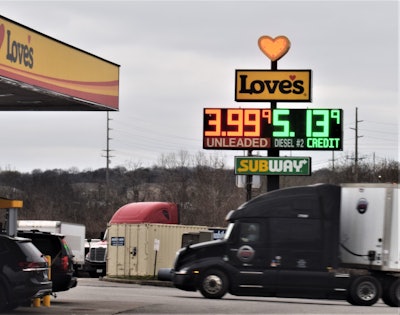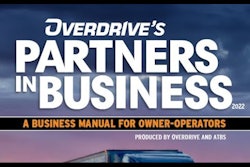Holy smokes? Yes, it's been quite a week and more on the fuel-cost front, with diesel now at a record-high national average and little relief in sight with panic in oil markets, further sanctioning of Russian oil, and inflationary pressures all around.
Even before the most recent week, Overdrive's owner-operator readers have been feeling inflation's pinch. Take note of these poll results around revenue/cost balance through the first part of this year.
Apart from profit/income trending negative in the short-term, the fuel hikes of this past week have been such that, as reported yesterday, owner-operator Kevin Boynton took the dramatic step of simply removing himself from all loads pre-booked for next week. Had he moved ahead, he said, he'd essentially be working for next to nothing given how fast fuel has risen.
"At the time I booked there was no inkling that fuel prices were going to do" what they're doing now, he told my colleague Alex Lockie. With pre-booked loads for this week, he added, "I’m basically covering my expenses and not putting anything in my pocket.”

He wasn't the only one feeling the pinch.
Shorter-haul dump small fleet owner Ronald Philpot, based in the Atlanta area, lamented his set-hourly-rate load contracts for hauls under 100 miles that don't include a fuel surcharge adjusting for price hikes. "I really think that the diesel fuel [costs are] outrageous," he said. "We have to go up on what we haul."
And it just keeps rising, from his vantage -- "it went up 10 cents last night."
Owner-operator Bob Ellis, leased in an operation where he dispatches himself across the Lower 48 from a home base in New Hampshire, saw fuel this past week go up 40 cents just over the course of a single run. In an environment like this, he feels like he's "always one step behind. It's hard to recoup [rising costs] once you sign the rate con."
Some of the agents he deals with are OK with his asks when negotiations send his rate upward, but it's hardly universal even now with trucking services in high demand. "Some people are OK," he said, but "some won't budge" from their offer rate.
Missouri-headquartered Landstar agent John Henderson spoke to similar dynamics with the owner-operators he's fed freight to in the past week, many seeing the quick rise in fuel before company-wide surcharge adjustments were able to offset the bulk of it, and "they’re begging for more out of the rate," he said. "Prices are going up so fast we can’t keep up with them. A lot of our customers have been willing to raise the rates, but not all."
I updated the following chart to include data from DAT Freight & Analytics for the weeks leading into March, after first publishing it in early February. What it shows is short-term declining underlying linehaul rates for brokered dry van and reefer loads on average, though such rates are still high compared to historical averages for sure.
(The trends in flatbed spot market linehaul, by the way, might be a bright spot out there, given they've generally been flat at around $2.65 or so -- that's minus an average surcharge as with the above -- since mid-December.)
DAT bases its surcharge calculations on the common $1.25/gal fuel cost, meaning the per-gallon price above that is divided by an average fuel mileage and then subtracted from what DAT's computing for average brokered rates to get the linehaul figures you see above. For dry vans, the fuel mileage used is 6.3 mpg, differing for reefers and flats.
Fast fuel hikes, DAT notes, and as owner-operator testimony above illustrates, put deflationary pressure on the base rate. With last week's 75-cent increase in the national average -- well more than that in some regions -- it equates to more than a 10-cent increase in fuel surcharges, where they come into play. If you're an independent booking with brokers, the all-in spot rate needs to account for that 10 cents to continue at similar profit levels, of course.
And in an environment like this, it probably goes without saying, do everything you know how to conserve fuel, meantime. If your fuel cost is getting up above 30% of revenue as a small fleet, an advisor recently said to me, the situation's bound to get uncomfortable, especially if a lot of maintenance is hitting the balance sheet, too.
 Another shot of the Love's here in Nashville from this week Monday, also as seen in yesterday's report by Overdrive News Editor Matt Cole -- I took a few different ones to preserve what's surely a historic event for this location. It's quite possible that No. 5 in the dollar column on the diesel sign has ever had to light up in this configuration before, eh? At least they know it works. Here's hoping we don't get a test of the 6 ...
Another shot of the Love's here in Nashville from this week Monday, also as seen in yesterday's report by Overdrive News Editor Matt Cole -- I took a few different ones to preserve what's surely a historic event for this location. It's quite possible that No. 5 in the dollar column on the diesel sign has ever had to light up in this configuration before, eh? At least they know it works. Here's hoping we don't get a test of the 6 ...
An old rule of thumb comes to mind, codified in Overdrive's Partners in Business manual's Chapter 5 on controlling fuel costs. It's that every single mph driven above 60 reduces fuel economy by a tenth of a mile per gallon. With what we're seeing now, that 61 mph might get you 8 miles farther down the road over the course of a typical eight hours' worth of daily driving. Yet it will cost you mightily at these prices. If you get 6 mpg, eight hours at 60 mph, with the $5.13 credit price we saw at the Love's here in Nashville on Monday, will cost you $410.40. Eight hours' worth at 61, though, increases that cost by about $14, or about 3%. The distance gain is a mere 1.66%. The higher the fuel price, then more dramatic the effect speed will have on costs.
The rule of thumb is not an exact one, though, noted past Overdrive Owner-Operator of the Year and longtime aerodynamics/fuel-mileage experimenter Henry Albert. Slowing down from higher speeds will have a greater net effect, he said, on fuel-mileage gains than at lower speeds. The difference between 64 and 65 when it comes aerodynamic drag is "a lot more is a lot more than the difference between 60 and 61."
Albert's recent-years experimentation with achieving equal to greater fuel mileage in an ultra-aerodynamic Cascadia at speeds above 70 mph illustrated the "bell curve" of aerodynamic drag. "When I tried to push it from 70 to 75 miles an hour that was really hard" to achieve, he said. "60 to 67 is not nearly as much" of an increase is drag.
If you've been running hard and fast, thus, you have even more to gain on fuel mileage with a speed reduction, and adjustment in that department is something anyone can do, anytime, without costly aerodynamics investment or other, slower-to-implement fuel-saving strategies. Of which there are many, of course, from enrollment in buying groups like the National Association of Small Trucking Companies' fuel card and leased owner-operators' fleet-group discounts to more local co-ops and so much more.
In addition to his separate Landstar agency business mentioned above, John Henderson also owns four (soon to be five) trucks today running leased to a different company in Canton, Missouri, hauling petroleum fuel and ethanol within about 200 miles of his home base. He notes for owner-operators and small fleets like his, hauling locally/regionally, bulk fuel contracts and other fuel hedging "resources could be right in their own community if they would just go ask."
That's what he started moving toward after the Biden administration's win in the 2020 election. "Through some people that I know that work for MFA Oil," an energy co-op headquartered in Columbia, Missouri, he found out that "they actually offer fuel contracts that you don’t have to pay up front" -- in other words, contracts that do not depend on bulk delivery to your own storage location.
 One of Henderson's four fuel-hauling rigs
One of Henderson's four fuel-hauling rigs
When he first started looking into it, the per-gallon rate he could get in the contract was "3-4 cents a gallon over the street price," but given trends in demand last year, moves toward spurring alternative power and more from the Biden administration, as well as global trends, he realized "it was to my benefit to look more closely at that. My first contract I bought was last October, at an average of $3.37 a gallon, and then I just signed another contract for 33,000 gallons at $3.67 a gallon. Everybody thinks I’m the smartest guy in the world all of a sudden."
Jokes aside, he "could see the conflict out of Russia causing if nothing else an image issue in the fuel industry" -- the panic we're seeing right now in oil markets -- "and I do like the comfort of knowing my fuel cost going forward."
 John Henderson
John Henderson
His current contract will take Henderson into October, when he'll re-assess.
"I’m sitting pretty good, for at least a while," he said. --Alex Lockie contributed to this report
Find plenty more on controlling fuel costs, as noted, in the Partners in Business manual and elsewhere on Overdrive. Join us at MATS or otherwise keep a lookout on the site here for March 25, when we'll introduce an updated version of the manual.
Spot market in the last week
Overall, the number of loads posted to the DAT One load board network fell almost 2% during the week of February 27 to March 5. The number of trucks posted rose 2.6% compared to the previous week, DAT reported, and there are now more trucks on the network searching for loads than at any other point this year.
The availability of spot van and reefer freight continues to pull back while flatbed loads are increasing, which is very much in line with seasonal expectations.
The number of dry van loads on the network fell 7% last week compared to the previous week. A 3% increase in posted trucks sent the national average van load-to-truck ratio down from 6.5 to 5.9 loads per truck.
The number of reefer loads dropped by 3% and has fallen 50% since the first week of January. The reefer load-to-truck ratio was 11.3 as a national average, down slightly week over week.
Flatbeds remained on the upswing, perhaps a reason for that linehaul-rates bright spot I mentioned above. Load posts up 1% compared to the prior week. Flatbed load posts have increased four weeks in a row. With equipment posts falling slightly, the national average flatbed load-to-truck ratio was 103.5 — it’s early in the year for this much demand, DAT said.
Key Market: Houston flatbeds
The number of loads moved on DAT’s 78 highest-volume flatbed lanes increased 3.7%, and rates were up or neutral on 55 of those lanes. There’s perhaps no greater concentration of flatbed demand than in Texas.
Houston is the No. 1 market for spot flatbed freight. All-in, the outbound spot flatbed rate averaged $3.52/mile last week, and many lanes paid well: Houston to Fort Worth averaged $3.82/ mile; Houston to Oklahoma City $3.32/mile; to El Paso $3.64. Houston's a gateway for oilfield services and construction materials. As the price of oil increases, exploration and production companies boost activity in the Permian Basin and elsewhere, expect this type of flatbed traffic to pick up.










